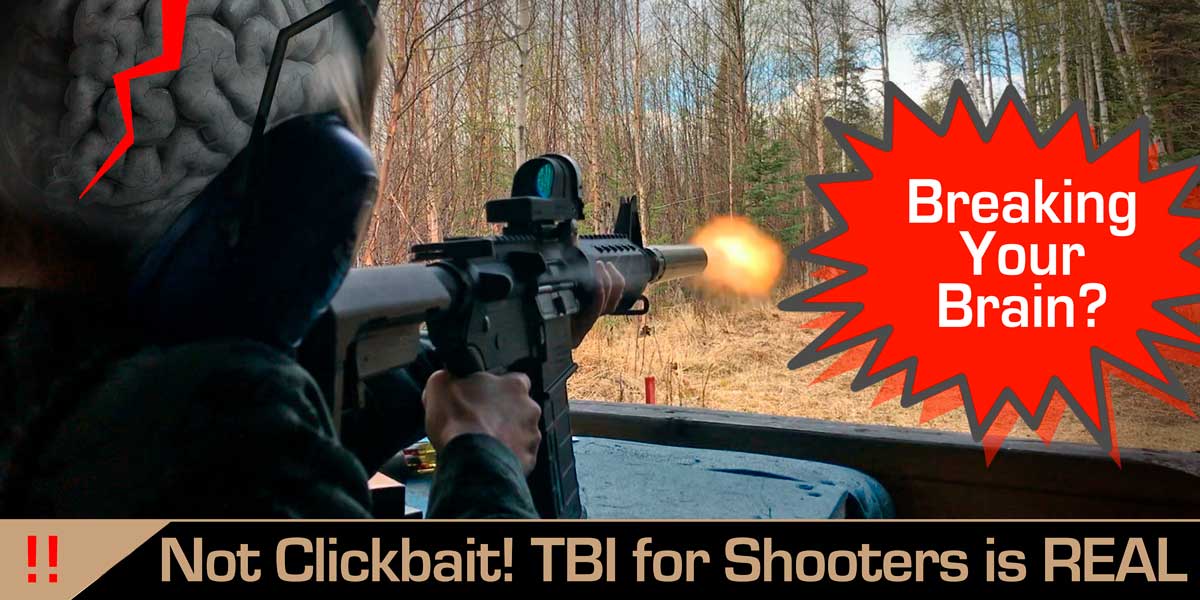 Personal protective equipment is necessary for many activities. We wear seat belts when we drive, helmets when we ride. Power tools require safety glasses.
Personal protective equipment is necessary for many activities. We wear seat belts when we drive, helmets when we ride. Power tools require safety glasses.
Shooting and hunting require personal protective equipment, and most modern shooters faithfully don ballistic glasses and wear hearing protection.
But one vital piece of protective equipment is often overlooked.
The Traumatic Brain Injury (TBI) Problem
This was painfully driven home to me again just yesterday at an informal shooting event.
We were on a small private range facility, and I was on an open short range assisting kids with shooting some pistols and .22 rimfires. After some time we moved to the rifle range.
This range consisted of a narrow lane and two shooting positions housed in a little plywood shed barely big enough to wrap around the bench inside. A window opened to provide a firing port at the front, and a door allowed admittance at the rear.
I brought an 11.5″ AR pistol for the kids to shoot. I sat at the bench and zeroed it, then closely supervised my youngest son as he began to shoot.
All went well until another shooter entered the shed with a 16″ 5.56 rifle. He fired a shot and in the enclosed space the noise and concussion battered us. Naturally focused intently on my son, the other shooter fired several shots before I recognized the feeling.
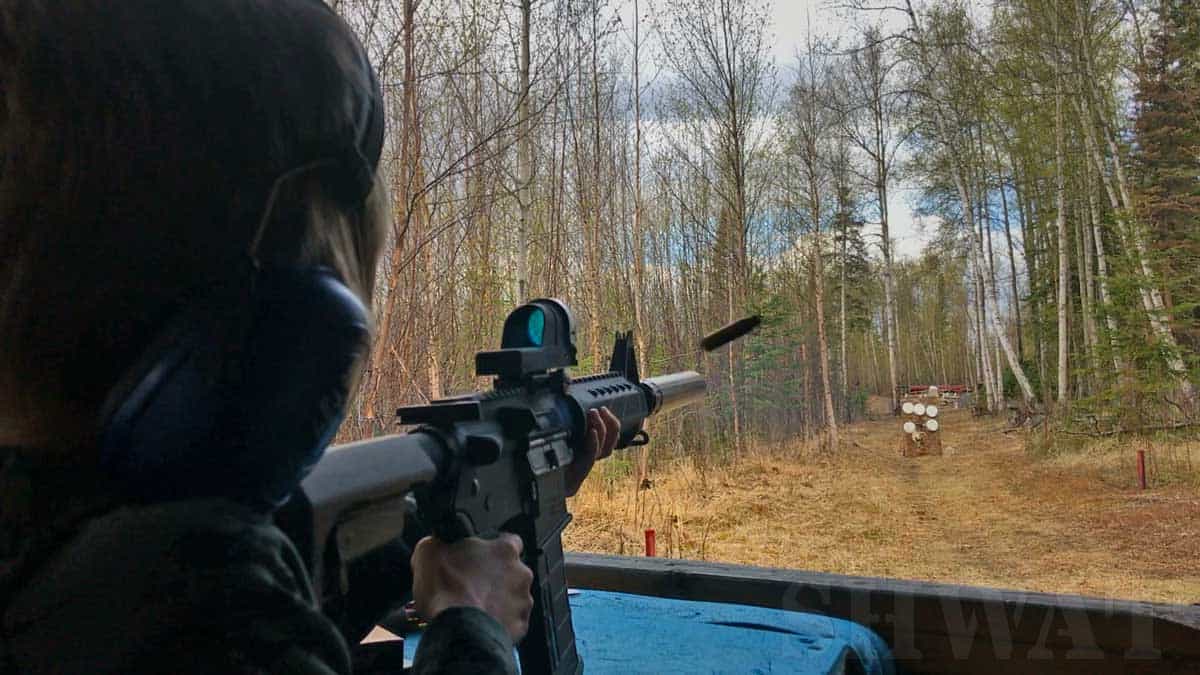
My son pulling triggers from this tight spot.
My Traumatic Brain Injury
I can best describe it as a bruised feeling inside my head, and a growing awareness that thinking is becoming a little more laborious; concentration begins to require more, well, concentration.
Continued exposure brings slight confusion and feelings of frustration. Above all is a feeling that something is hurting me inside my head. I instinctively feel a need to protect my head.
Several years ago a buttstock strike to the side of my head, some bombs exploding in close proximity, and a brick thrown from a third story balcony left me with Traumatic Brain Injury (TBI).
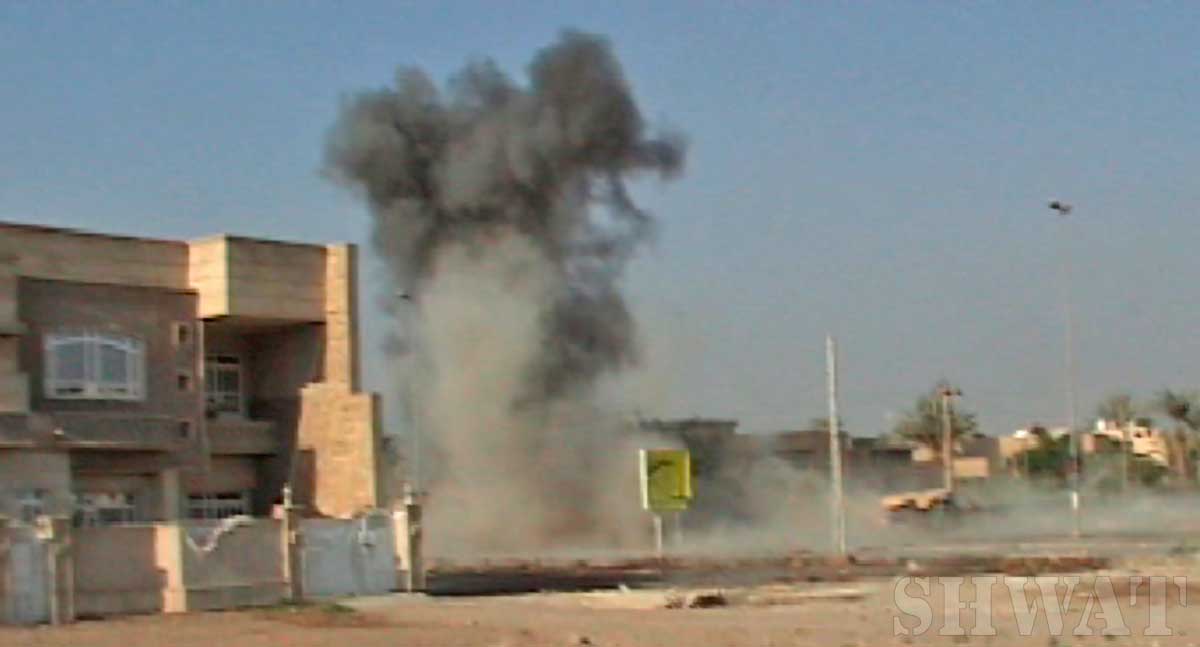
This is a photo of a bomb that rattled my brain bucket. Another soldier happened to catch it on film. Notice the dust raised across the ground from the initial blast waves. I was just on the other side, hidden in the dust.
Traumatic Brain Injury is More Common Than You Think
Traumatic Brain Injury is cumulative – it can increase in severity with subsequent concussions. The damage caused by the concussion of explosions is far more worse than previously thought. But the blast pressure levels required to cause TBI are much lower than previously thought.
Children and teenagers are especially susceptible to brain injury from concussions; at certain stages of development they are extremely susceptible, as are people with existing TBI.
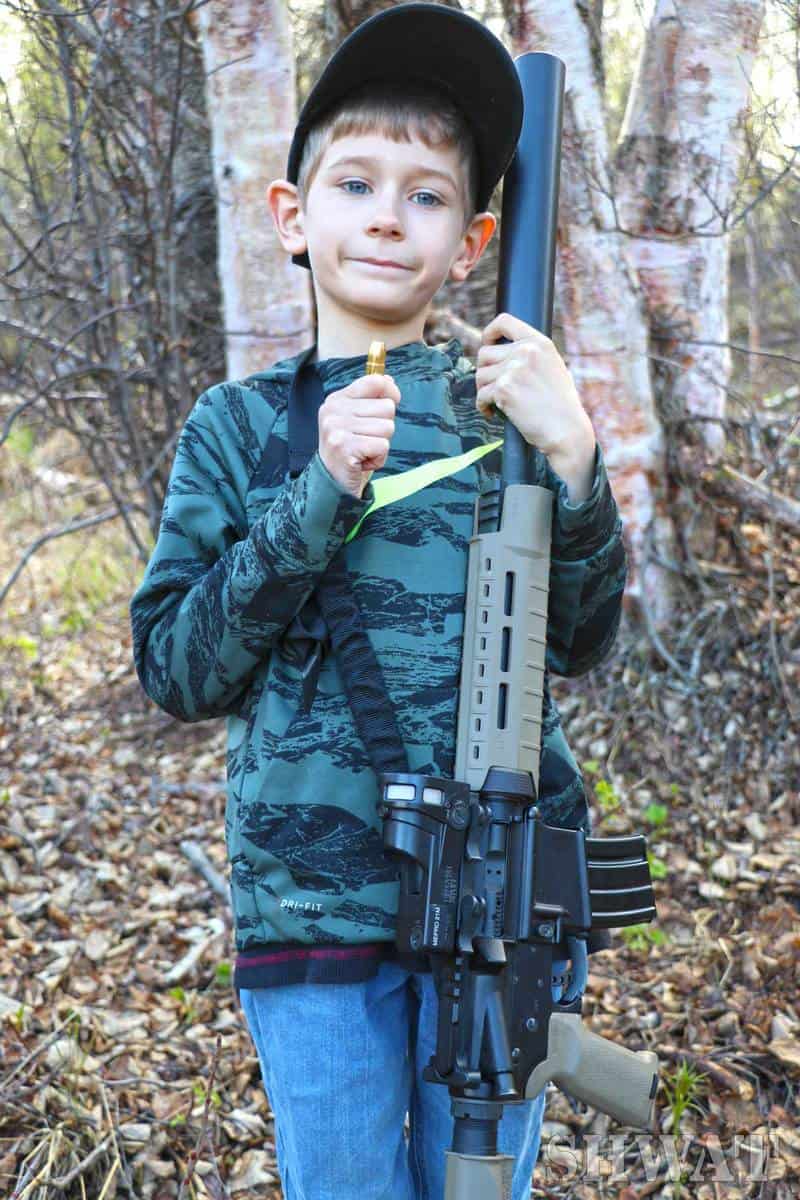
This boy loves shooting, but there’s no way I want to put him in a position that could cause TBI.
By 2007, head injuries became the most common injuries for which soldiers are treated. The military has records of nearly 380,000 soldiers who suffered TBI in combat, but many estimate the true numbers are over double that figure.
Brain injuries remain underreported in the military due lack of diagnosis, soldiers and leaders who are ignorant about the severity of these injuries, or who focus on the mission and do not report the injury or seek treatment.
Most significantly, little was understood about the compounding effects of low-level blasts over time.
How TBI Occurs
Researchers use a number of methods to research the primary effects of blast waves on the brain, including transferring the primary blast wave to mice and rats through a membrane in a tube, while protecting the animals from secondary or tertiary effects.
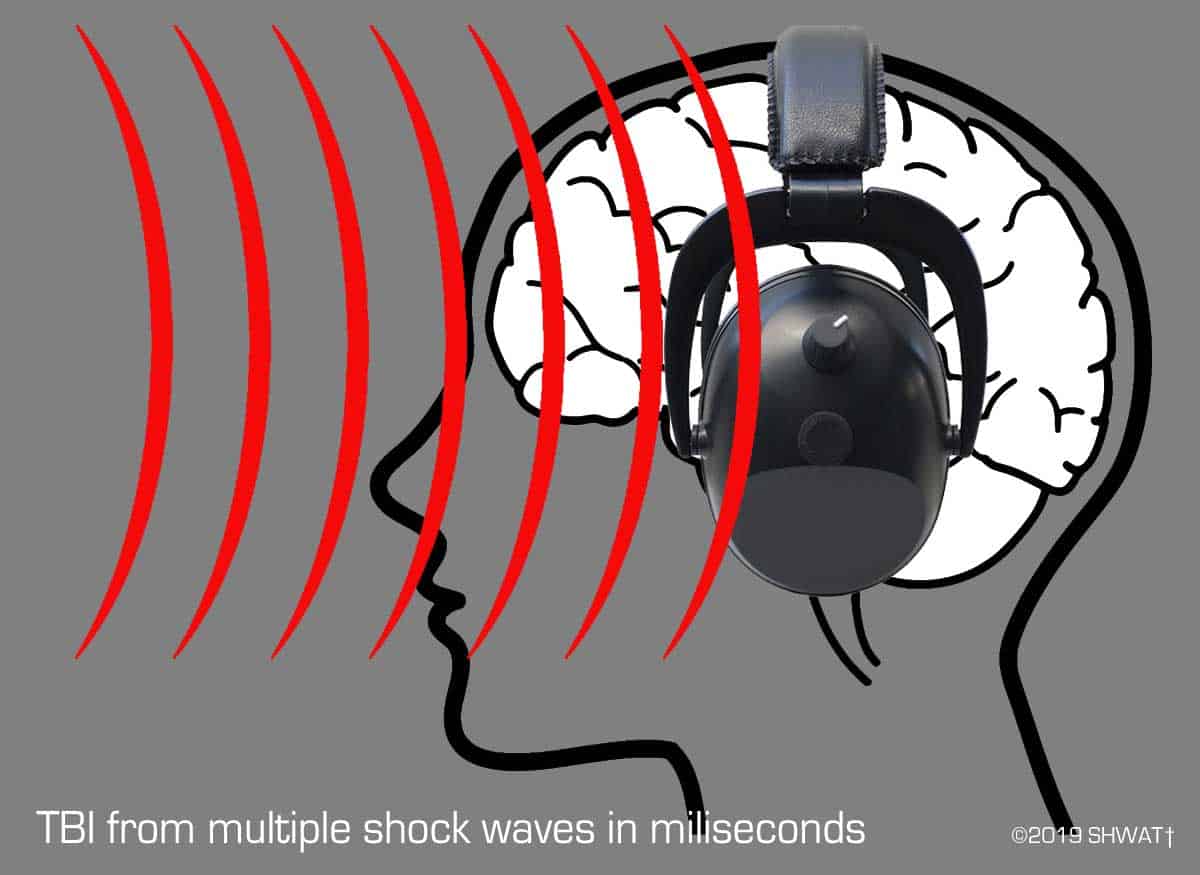 It appears that rather than suffering a single blow during a TBI event, a person is absorbs a series of shocks within milliseconds. At least one writer describes the effect as to getting punched repeatedly by a boxer in less time than it takes to blink.
It appears that rather than suffering a single blow during a TBI event, a person is absorbs a series of shocks within milliseconds. At least one writer describes the effect as to getting punched repeatedly by a boxer in less time than it takes to blink.
This makes sense to me. Today I am an explosives engineer, I do blasting for construction and demolition, seismic exploration, navigation hazard removal, slope stabilization and re-routing water flow. When I film blasts in slow motion (slow enough to see individual charges go off within milliseconds of each other) the camera shakes as if from successive blows. But when it shakes the real evidence: After the charges begin to fire and before the secondary effects of the blast could reach the camera.
I have also seen this effect from slow-motion filming of firearms with muzzle brakes.
TBI and Trigger Pullers – The Science
Several years ago, some Israeli special forces personnel told me that the IDF was reconsidering the fielding of .50 sniper rifles due to determining that they were causing TBI among their snipers.
 A 2018 Center for a New American Security report along with several other DoD studies have determined that training with shoulder-fired weapons and large-caliber rifles is leading to measurable brain injury in some soldiers:
A 2018 Center for a New American Security report along with several other DoD studies have determined that training with shoulder-fired weapons and large-caliber rifles is leading to measurable brain injury in some soldiers:
“DoD studies have demonstrated that some service members experience cognitive deficits in delayed verbal memory, visual-spatial memory, and executive function after firing heavy weapons, even within allowable limits.”
“DoD studies have also found higher rates of concussion and post-concussion associated symptoms among individuals with a history of prolonged exposure to low-level blasts from breaching and shoulder-fired weapons.”
Twenty-one percent of pigs in an animal study exhibited hemorrhaging in the brain after being exposed to the concussion from 3 shots from a .50 BMG caliber rifle.
How Much is Too Much?
How much blast overpressure is too much? It turns out no one really knows. The only thing experts can confidently say regarding TBI and overpressure levels is this: They occur at levels much lower than anyone previously understood. According to a National Geographic article by Oliver Payne:
“So exposure to five psi will rupture your eardrums, fifteen psi will damage your lungs, and so forth. The astonishing thing? The brain isn’t even mentioned on these conventional lists . . . . And the blunt truth is, no one knows… We only know that it’s a lot lower threshold than used to be imagined. There’s a lot of evidence that repetitive exposure to relatively low-level blast is damaging . . .”
Much of the military concern is about .50 sniper rifles. This is a weapon I was issued in the military, but I will no longer shoot one or be near someone shooting one unless it has a suppressor.
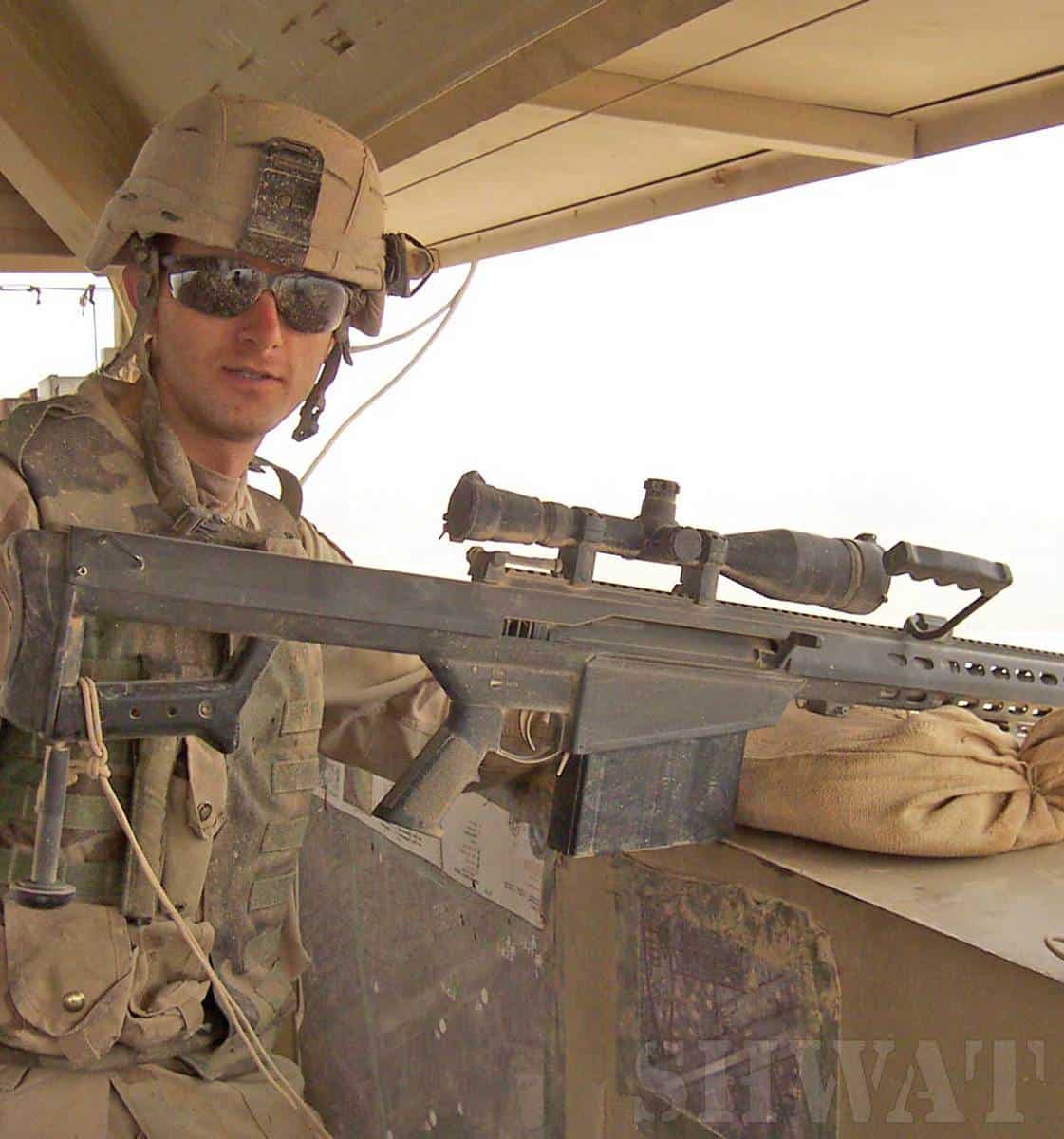
Me with my Barrett XM107
It’s Not Just the .50 That is Dangerous
I can feel when something is affecting my brain. I imagine I am sensitive to it due to my existing injury. But .50 caliber rifles are not the only firearms that cause this effect for me.
I experience this when instructing or filming students who are shooting next to walls or in confined spaces, especially when the caliber is 5.56 with a 16″ or shorter barrel. The same is true when around a 16″ barreled .308, most severely with a brake or certain flash hiders.
I know people with Mausers or Mosin Nagants with short (as in 8″) barrels and I can be nowhere in proximity when they are fired. Magnum caliber rifles with muzzle brakes or various caliber rifles with certain brakes leave me feeling concussed.
One offender is very short AR-15s, which have widespread popularity. They are short, light, with low recoil, but shooting one is akin to having a flashbang go off in front of your face.
The TBI Solution
So if a 16″ barreled AR in an enclosed space rattles my fillings, I must be severely brain injured to purposely bring an AR with an 11.5″ barrel into that situation, right?
Prior to leaving the house with my boys yesterday, I grabbed an essential piece of personal protective equipment and put it in my bag. Quickly spinning the flash hider off the barrel, I replaced it with a threaded adapter and headed out the door.
At the range, I pulled out a Bowers Vers 30 suppressor and spun it on prior to shooting. The Vers 30 is a 30 caliber can that I use for 6.5 Grendels and .30 caliber rifles. With interchangeable inserts, I can thread it onto any rifle with a .30 caliber or smaller bore.
As long as we shot suppressed, the experience proved pleasant. Adding an unsuppressed AR to the mix made it unpleasant for everyone, including the other shooter.
A suppressor provides superior recoil reduction while protecting the shooter from noise and blast. You can tame the recoil on that magnum caliber rifle by making it excessively loud with a brake, or by making it quiet with a can.
My eight-year-old son, who weighs 41 pounds, was happily blasting water jugs apart with a .50 Beowulf AR pistol. He suavely handled the recoil tamed by a Bowers Vers 50 suppressor.
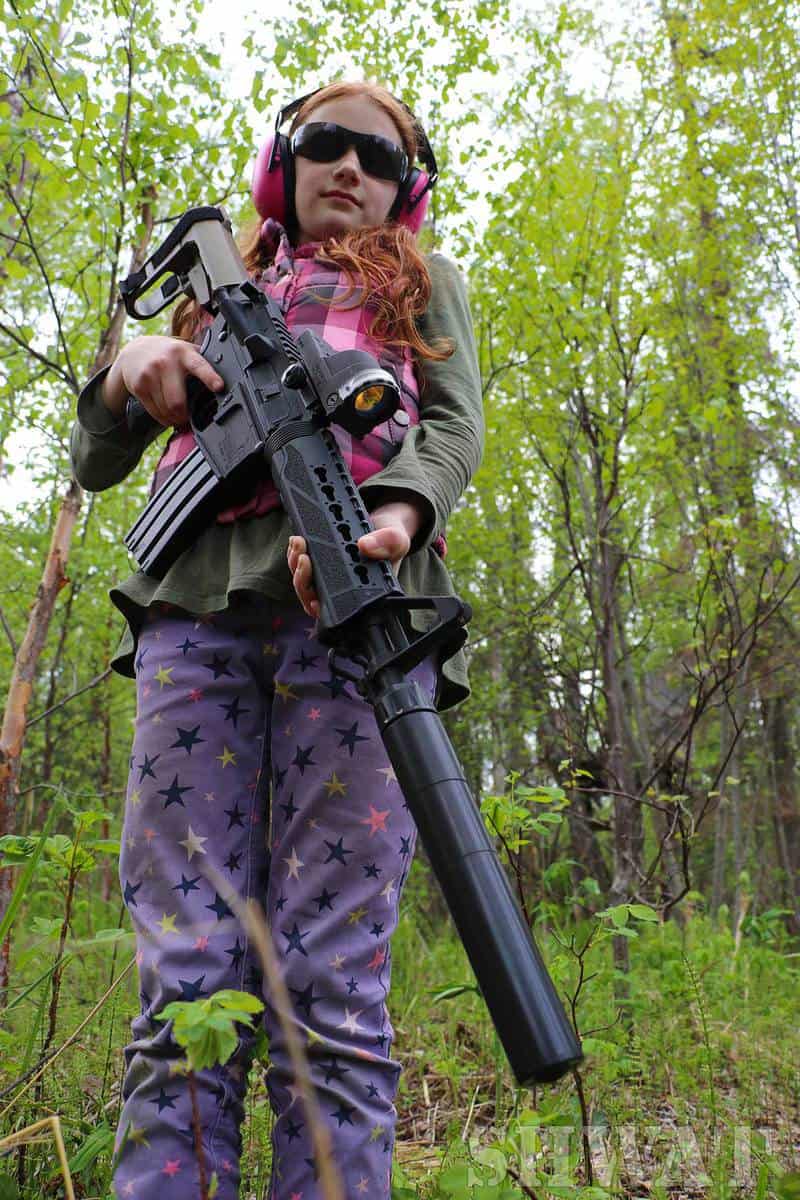
No TBI allowed here!
Why Risk It?
Short barrels, muzzle brakes, heavy calibers, and confined spaces, singly or in conjunction, all have the potential to increase the concussion of shooting to a level that could cause cumulative traumatic brain injury.
This isn’t the case with every firearm, every caliber, or every situation. But if you have a rifle creates more than the normal amount of concussion when you fire it, it’s time to put a suppressor on it. Protect your ears and your brain. Living with TBI is no fun. Why risk it?
Fish, Lauren and Scharre, Paul. “Protecting Warfighters from Blast Injury”. cnas.org, Center for New American Security, April 29, 2018, cnas.org/publications/reports/protecting-warfighters-from-blast-injury
Kesling, Ben. “Weapons Training Likely Causes Brain Injury in Troops, Study Says”. wsj.com, The Wall Street Journal, April 30, 2018, wsj.com/articles/weapons-training-likely-causes-brain-injury-in-troops-study-says-1525060860
Alexander, Caroline. “Blast Force, The Invisible War on the Brain”. National Geographic, nationalgeographic.com/healing-soldiers/blast-force.html
Payne, Oliver. “Why Is the Mystery of Blast Force Brain Injury So Tough to Solve?”. National Geographic, February 17, 2015, news.nationalgeographic.com/news/2015/02/150217-shell-shock-ptsd-tbi-world-war-one-ied-veterans-administration-science/


Hi, I’m not sure I will ever get a response to this, but your article covered some things I have been very interested in. I am a former army reservist, eagle scout, shooter. A mistake at muay thai a year and a half ago gave me a tbi that gave me serious problems, and I am only recently able to do my work again. Shooting was something I loved doing, and I have been considering a career as a park ranger. My perspective now is this: getting another tbi would be the worst thing I could imagine. This whole experience almost killed me, so I don’t want to do anything that even MIGHT cause concussion/sub concussion, whatever. You talk about concussion from firearms like you can just “feel out” whether you are taking damage or not. How can you be sure that you are not accumulating sub concussive damage that will eventually cause another TBI? Respectfully, are you out of your mind or do you know something that I don’t? I would love to shoot again but it doesn’t seem like the science is there yet.
Hey Keith, I’m sorry to hear about your TBI. I hope that you have been and are receiving good treatment, that is vital.
I can sometimes feel if I am being affected by certain things, but not reliably. Often I don’t notice until some time has passed, as I subconsciously push it to the background.
I certainly don’t want to determine if I am taking cumulative damage by trying to feel it out, by then it is already to late.
Most research has been centered on weapons like the .50 BMG rifles with brakes and AT-4s, etc., so as you say, the science is a little sparse on smaller caliber firearms.
I have not stopped shooting, but I pay attention to my shooting and stay away from certain conditions. Here are some things I do:
1. I mostly stick with standard pressure cartridges, for example, .308 or .30-06 instead of .300 RUM.
2. I avoid muzzle brakes, especially on heavier cartridges or shorter barrels. Instead, I find other ways to manage recoil if necessary. For example, the Alexander Arms Ulfberht .338 Lapua rifle has recoil similar to a .243 without needing a muzzle brake, while almost every other .338 Lapua rifle requires a brake to be shootable.
FAB Defense’s GL-SHOCK buttstock does an outstanding job of combatting felt recoil and muzzle rise on any firearm that can accept a collapsible AR-15 type stock; and is better for keeping the muzzle down than any brake I have seen on a 5.56.
Most rifles that have brakes installed do not need them at all. I have never seen a 5.56 or 7.62×39 that I felt needed a brake, nor have I needed one on any .308, .30-06, etc. that I have shot.
If you are recoil sensitive for any reason (there are medical conditions that affect this, such as problems with shoulders, necks, or eyes, so please let’s leave out comments about being manly), there are calibers that are very effective yet very soft on the shoulder. Calibers in the 6mm to 7mm range can tend toward better down-range effectiveness than .30 calibers and above, due to the science of efficient design.
6.5 Grendel is an outstanding choice, with very low recoil, yet astounding terminal ballistics on game.
6.5×55 very tame to shoot, and 7×57 Mauser or 7mm-08, with recoil almost as easy to handle as the 6.5×55.
In the big bores, a lever-action chambered in .45 Colt with heavy loads, or even better, in .454 Casull exceeds the performance of many standard-pressure factory .45-70 loads, and climbs into the realm of the lower end of heavy .45-70 loads but without the heavy recoil.
In a short AR pistol or carbine, .50 Beowulf gives the equivalent of heavy-loaded .45-70 cartridges, but with negligible recoil.
3. I avoid doing any shooting in confined spaces or next to walls when possible.
4. I avoid unreasonably short barrels. This is caliber-specific. An 8mm Mauser, or .308 with an 8″ barrel will ring your bell. A 5.56 at that length will be pretty unpleasant too. I don’t like to shoot most calibers in less than a 16-20″ barrel, depending on caliber. But a .300 BLK in an 8″ barrel isn’t as bad, nor a 6.5 Grendel in an 11″ barrel, or a Beowulf in 12″.
5. I avoid stocks that fit me so poorly as to cause my cheek to feel like it has suffered a blow. I have seen this only in a couple rifles in me whole life. It is more common in certain shotguns, in which personal fit can be more critical.
6. I see suppressors as the greatest safety device for avoiding cumulative brain injury. Any rifle that can be tamed by a brake can be better tamed by a suppressor. The suppressor eliminates almost all concussion felt by the shooter and bystanders. It also protects hearing. It allows me to shoot in enclosed spaces, or next to walls, and it allows me to hunt without having to wear hearing protection. It allows me to shoot heavier calibers without resorting to a muzzle brake, and it allows me to shoot short barrels.
I don’t recommend that you stop shooting, but I do recommend that you tailor your firearms and shooting to prevent any further injury to your brain. I do feel that once you have TBI with noticeable symptoms, that you are more susceptible to causing damage than others may be.
Hi, I really appreciate the manner with which you are addressing this topic. As you said, most shrug it off as not being man enough. I have a complicated TBI and have found shooting at indoor ranges to be increasingly difficult just from the persons shooting next to me at the range. Do you know of any type of cap that is available to wear that protects from this sort of thing. I’m thinking there has to be something that can be worn (maybe in the form of a watch cap) to mitigate blast concussion. Are you aware of anything like this?